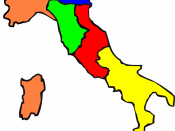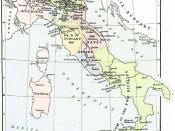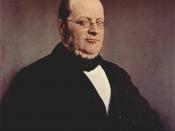ITALIAN UNIFICATION
"Qui si fa l'Italia o si muore "
("Here we make Italy -- or die!" Guiseppe Garibaldi, at the battle of Calatafimi, in Sicily, 15th May 1860)
The Risorgimento is the process by which the modern country of Italy was forged from a collection of individual Italian States linked only by geography. It started with the ending of Napoleon's reign and the Congress of Vienna in 1815, and ended with the Franco-Prussian War in 1870-71. Throughout that period the unification of Italy dominated European politics: with personalities such as Cavour, Mazzini and, of course, Garibaldi becoming household names.
In Italian, risorgimento literally means resurgence. But the historical sense is one of rebirth. But of what? Its champions variously hoped for independence from foreign rule, the development of national self-consciousness, national unity, a renewal of morality in government, and eventual national greatness. It is clear that the Risorgimento led to national unification.
It led, but only slowly, to a national identity. The other goals were only incompletely or intermittently achieved by the end of the twentieth century. Since the fall of the Roman Empire in the fifth century the Italian peninsular had not been a unified political power instead it comprised of partitioned powers known as city states and papal states. Between the fifteenth and eighteenth century 'Italy' was plagued by foreign domination.
The concept for the desire of an Italian national identity can be traced back far to the seventeenth and eighteenth centuries. Both Machiavelli and Dante envisaged 'Italia' as a cultural nationalist expression. S. Battilini, Carlo Denina also wrote in terms of an Italian identity.
However, the period described as the 'Risorgimento' (meaning revival or new-birth) can be said to have started in 1815 with the ending of Napoleon's reign and the Congress of Vienna.


